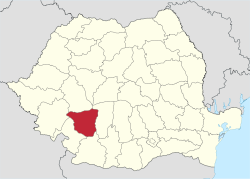Gorj County
Gorj County
Județul Gorj | |
|---|---|
County | |
 | |
| Country | |
| Development region1 | Sud-Vest |
| Historic region | Oltenia |
| Capital city (Reşedinţă de judeţ) | Târgu Jiu |
| Government | |
| • Type | County Board |
| • President of the County Board | Ion Călinoiu |
| • Prefect2 | Ştefan-Marian Popescu-Bejat |
| Area | |
| • Total | 5,602 km2 (2,163 sq mi) |
| • Rank | 21st in Romania |
| Population (2002) | |
| • Total | 387,308 |
| • Rank | 28th in Romania |
| • Density | 69/km2 (180/sq mi) |
| Time zone | UTC+2 (EET) |
| • Summer (DST) | UTC+3 (EEST) |
| Postal Code | 21wxyz3 |
| Area code | +40 x534 |
| Car Plates | GJ5 |
| GDP | US$ 3.72 billion (2008) |
| GDP/capita | US$ 9.599 (2008) |
| Website | County Board County Prefecture |
| 1 The development regions of Romania have no administrative role and were formed in order to manage funds from the European Union 2 as of 2007, the Prefect is not a politician, but a public functionary. He (or she) is not allowed to be a member of a political party, and is banned from having any political activity in the first six months after his resignation (or exclusion) from the public functionaries' corps. 3w, x, y, and z are digits that indicate the city, the street, part of the street, or even the building of the address 4x is a digit indicating the operator: 2 for the former national operator, Romtelecom, and 3 for the other ground telephone networks 5used on both the plates of the vehicles that operate only in the county limits (like utility vehicles, ATVs, etc.), and the ones used outside the county | |
Gorj (Romanian pronunciation: [ɡorʒ] ) is a county (judeţ) of Romania, in Oltenia, with its capital city at Târgu Jiu.
Demographics
In 2011, it had a population of 334,238 and its population density was 59.66/km².
| Year | County population[2] |
|---|---|
| 1948 | 280,524 |
| 1956 | |
| 1966 | |
| 1977 | |
| 1992 | |
| 2002 | |
| 2011 |
Geography
This county has a total area of 5,602 km².
The North side of the county consists of various mountains from the Southern Carpathians group. In the West there are the Vulcanului Mountains, and in the East there are the Parâng Mountains and the Negoveanu Mountains. The two groups are split by the Jiu River.
To the South, the heights decrease through the hills to a high plain at the Western end of the Romanian Plain.
The main river, which collects all the smaller rivers, is the Jiu River.
Neighbours
- Vâlcea County to the east.
- Mehedinţi County and Caraş-Severin County to the west.
- Hunedoara County to the north.
- Dolj County to the south.
Economy
The predominant industries in the county are:
- Mining equipment industry.
- Food and beverages industry.
- Textile industry.
- Mechanical components industry.
- Glass industry.
- Wood industry.
In the North of the county coal is extracted, near Motru and Rovinari. There are two big thermo electrical power plants at Rovinari and Turceni, and some hydro-electrical power plants. The county is the biggest electricity producer in Romania with 36% af the country's electricity.
Due to the decrease in mining activity, the county has one of the highest unemployment levels in the country.
Tourism

The main touristical destinations are:
- The city and the area around Târgu Jiu:
- The Parâng Mountains.
- The Polovragi Monastery.
Politics
The Gorj County Council, elected at the 2016 local government elections, is made up of 33 counselors, with the following party composition:[3]
Administrative divisions
Gorj County has 2 municipalities, 7 towns and 61 communes
- Municipalities
- Communes
- Albeni
- Alimpești
- Aninoasa
- Arcani
- Baia de Fier
- Bălănești
- Bălești
- Bărbătești
- Bengești-Ciocadia
- Berlești
- Bâlteni
- Bolboși
- Borăscu
- Brănești
- Bumbești-Pițic
- Bustuchin
- Câlnic
- Căpreni
- Cătunele
- Ciuperceni
- Crasna
- Crușeț
- Dănciulești
- Dănești
- Drăgotești
- Drăguțești
- Fărcășești
- Glogova
- Godinești
- Hurezani
- Ionești
- Jupânești
- Lelești
- Licurici
- Logrești
- Mătăsari
- Mușetești
- Negomir
- Padeș
- Peștișani
- Plopșoru
- Polovragi
- Prigoria
- Roșia de Amaradia
- Runcu
- Săcelu
- Samarinești
- Săulești
- Schela
- Scoarța
- Slivilești
- Stănești
- Stejari
- Stoina
- Țânțăreni
- Telești
- Turburea
- Turcinești
- Urdari
- Văgiulești
- Vladimir
References
- ^ National Institute of Statistics, "Populaţia după etnie"
- ^ National Institute of Statistics, "Populaţia la recensămintele din anii 1948, 1956, 1966, 1977, 1992 şi 2002"
- ^ "Mandate de CJ pe judete si competitori" (in Romanian). Biroul Electoral Central. 10 June 2016. Retrieved 16 June 2016.


